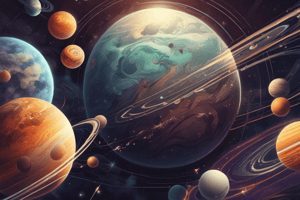Podcast
Questions and Answers
What is the primary source of light and heat for our solar system?
What is the primary source of light and heat for our solar system?
- Moon
- Sun (correct)
- Earth
- Mars
The Moon is a planet.
The Moon is a planet.
False (B)
What is the process by which stars generate energy?
What is the process by which stars generate energy?
nuclear fusion
The largest planet in our solar system is _______________.
The largest planet in our solar system is _______________.
Match the following astronomical objects with their characteristics:
Match the following astronomical objects with their characteristics:
Study Notes
Celestial Bodies and Energy
- The primary source of light and heat for our solar system is the Sun.
Incorrect Information
- The Moon is not a planet.
Stellar Energy Generation
- The process by which stars generate energy is through nuclear reactions in their cores.
Our Solar System
- The largest planet in our solar system is Jupiter.
Studying That Suits You
Use AI to generate personalized quizzes and flashcards to suit your learning preferences.
Description
Test your knowledge of the NJ Next Generation Science Standards for astronomy, covering topics such as the source of light and heat, planetary facts, and star energy generation.




